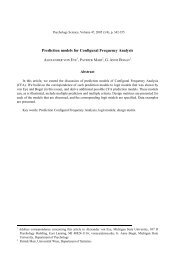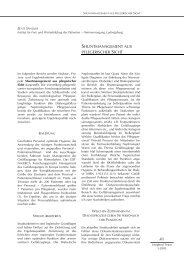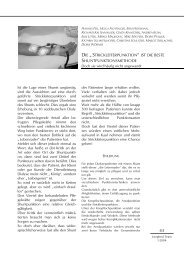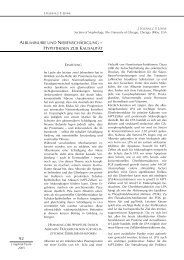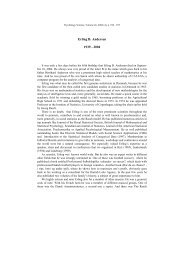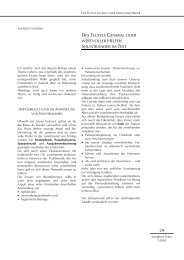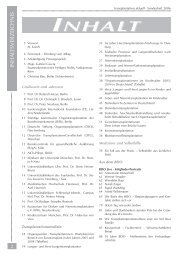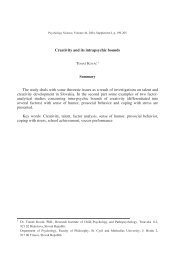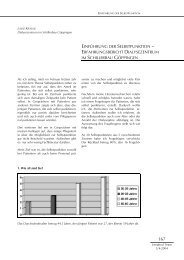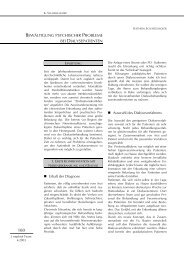Identifying rater effects using latent trait models Abstract
Identifying rater effects using latent trait models Abstract
Identifying rater effects using latent trait models Abstract
You also want an ePaper? Increase the reach of your titles
YUMPU automatically turns print PDFs into web optimized ePapers that Google loves.
Rater <strong>effects</strong> 47<br />
Table 2:<br />
Number of Essays Consistent with Rater Effect<br />
Rater<br />
Accurate<br />
Inaccurate<br />
Central<br />
Extreme<br />
Deviation from Mean of All Raters<br />
0 to 1 point 2 or more points<br />
24<br />
4<br />
20<br />
8<br />
Proximity to Own Mean versus<br />
Proximity of Mean of All Raters to Overall Mean<br />
Closer<br />
Farther<br />
16<br />
12<br />
6<br />
22<br />
essays while the inaccurate <strong>rater</strong> was within one rating scale category of the average of all<br />
<strong>rater</strong>s on only 71% of the essays. In rating programs that employ adjudication procedures<br />
when two <strong>rater</strong>s assign ratings that are more than one point apart, the adjudication rate of the<br />
inaccurate <strong>rater</strong> would be considerably higher than the adjudication rate of the accurate <strong>rater</strong>.<br />
Similarly, the bottom section of that table compares the distance the ratings of two <strong>rater</strong>s<br />
– one meeting the centrality criteria and one meeting the extremism criteria – lie from their<br />
own mean ratings to the distance each average rating (across the 101 <strong>rater</strong>s) lies from the<br />
mean of all of these averages. These figures clearly demonstrate that the extreme <strong>rater</strong> assigns<br />
ratings that are much more widely dispersed than a typical <strong>rater</strong> – 79% of the ratings<br />
assigned by that <strong>rater</strong> were farther away from that <strong>rater</strong>’s mean than were the average ratings<br />
from their own mean. Similarly, albeit a less pronounced effect, the central <strong>rater</strong> assigned<br />
ratings that were closer to that <strong>rater</strong>’s mean (than the average rating was to the mean of all of<br />
these average ratings) 57% of the time.<br />
Frame of Reference<br />
It is important to note that the frame of reference for interpreting these <strong>rater</strong> <strong>effects</strong> has<br />
been the pool of <strong>rater</strong>s. This requires one to assume that, on average, the pool of <strong>rater</strong>s contains<br />
only a very small proportion of <strong>rater</strong>s who exhibit <strong>rater</strong> <strong>effects</strong>. For example, because<br />
<strong>rater</strong> harshness and leniency are measured as deviations from the average rating across all<br />
<strong>rater</strong>s, an implicit assumption required to interpret <strong>rater</strong> location parameter estimates is that<br />
there is no prevalence of harshness or leniency among the <strong>rater</strong>s in the pool. This may or may<br />
not be the case. For example, in the data reported here, the average rating across the 101<br />
<strong>rater</strong>s and the 28 essays equals 4.39. On the other hand, the average consensus score assigned<br />
by the pool of six expert <strong>rater</strong>s to these same essays equals 3.79. Hence, on average, <strong>rater</strong>s in<br />
this study were lenient when compared to the experts. This fact illustrates an important problem<br />
in the analysis of <strong>rater</strong> <strong>effects</strong> – nearly all of the procedures based on <strong>latent</strong> <strong>trait</strong> measurement<br />
<strong>models</strong> employ a normative frame of reference and the use of such a frame of reference<br />
requires an assumption that <strong>rater</strong> <strong>effects</strong> are randomly distributed and are exhibited by<br />
only a minority of the <strong>rater</strong>s in the pool.



